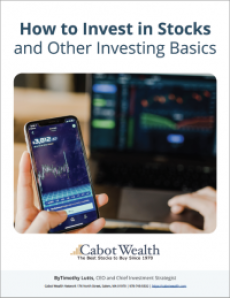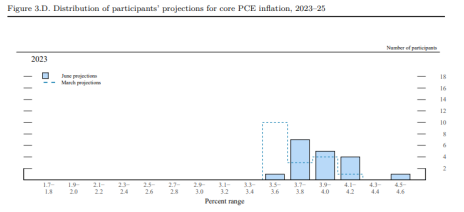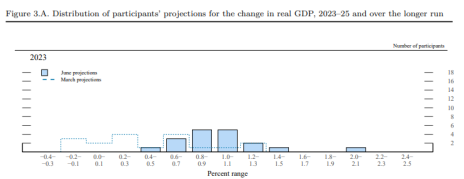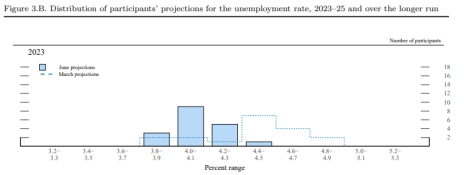The Federal Open Market Committee holds eight regularly scheduled meetings each year. In these meetings, “the Committee reviews economic and financial conditions, determines the appropriate stance of monetary policy, and assesses the risks to its long-run goals of price stability and sustainable economic growth.”
Accompanying four of those meetings (March, June, September, December) is the release of the Fed’s quarterly Summary of Economic Projections, in which Fed members (anonymized) make their projections for inflation, employment and growth.
Per the FOMC, “More specifically, the numbers that they provide for each of the years in their forecast are: the percent change in gross domestic product adjusted for inflation (real GDP), the unemployment rate, the percent change in the price index for personal consumption expenditures (PCE inflation), and the percent change in the price index for PCE excluding food and energy (core PCE inflation). Changes in real GDP and prices are measured from the fourth quarter of one year to the fourth quarter of the next. The unemployment rate is the average civilian unemployment rate in the fourth quarter of a year.”

Get My Free Report Now

Get My Free Report Now

Get My Free Report Now

Get My Free Report Now
The Summary of Economic Projections is widely followed by Fed watchers and market participants because it reveals more detail about how closely the economic impact of rate changes is tracking with Fed expectations.
Moreso than headline rate numbers or the oft-repeated “higher for longer” mantra, the Summary of Economic Projections allows investors to gain actual insight into how members are thinking. In other words, you can use the Fed projections to identify periods when inflation, employment or GDP growth results are not matching the results members would otherwise expect given their policy choices.
Reading the Summary of Economic Projections
The FOMC offers a useful breakdown of the various facts and figures in the Summary of Economic Projections here. For our purposes, we’ll take Fed Chair Jerome Powell at his word and assume the base case is “higher for longer” while emphasizing Core PCE (his preferred measure of inflation), GDP, and unemployment.
The examples below are from the June meeting and can be compared to the figures that will accompany the September meeting.
But first, a couple notes. The images below feature two graphical elements, a blue bar chart and dotted lines (they represent the last meeting’s bar charts for comparison to March’s numbers). Fed members make individual projections in a 0.1% range, which are then counted (right axis) to create that quarter’s expectation graphs for where each of these numbers will be at year’s end. For example, in this Core PCE chart, the most “popular” prediction for 2023 was 3.7-3.8%, with 7 votes – up slightly from the 3.5-3.6% expected in March. The materials at the link above include projections for 2024 and 2025, but we’ll only be showing figures for 2023. This is best approached with the mindset of looking at the rate of change: E.g., are the short-term expectations accommodative of the intermediate-term expectations, and can those support the longer-term headline rates?
Core PCE
This table (from pg. 8 of the link above) shows that Fed members moderately shifted their expectations for core PCE inflation higher between the March and June meetings. Stability in the projections in September (as compared to the June report) would help make a case for no further hikes from the Fed.
By that same token, significantly higher or lower projections make a case for a further hike this year or earlier rate cuts next year, respectively.
Seeing these expectations can also help contextualize other inflation data as it comes in and demystify some of the “good news is bad news” elements of the market. The Fed expects core PCE to fall to 2.1-3.6% in 2024 and then to 2-3% in 2025. The important takeaway is that incremental inflation information should continue to support that path broadly.
GDP
This chart of GDP expectations (pg. 4 in the link above) shows that the unexpectedly strong U.S. economy is not lost on the Fed, as the expectation range fully flipped out of negative GDP growth for 2023.
Expectations for 2024 are nearly identical, and the Fed sees 1.4-2.3% GDP growth in 2025.
Evidence that the U.S. economy is still running “too hot” for the Fed’s taste (GDP out of range without a clear path back to their projected range) would likely prompt further rate hike expectations.
Unemployment
As you can see in the unemployment chart (pg. 6), the Fed’s unemployment expectations moderated slightly between March and June, but they expect the unemployment rate to rise to 4-5.1% for 2024 before settling back down between 3.8-4.9% in 2025.
Persistent tight employment conditions (again, that don’t validate the longer-term path) would also be more likely to extend the duration of the high-rate environment or prompt another round of hikes.
The Fed’s two most powerful tools, rate policy and asset buying (quantitative easing or tightening), are massive economic dials, and as they make minor adjustments to those dials, they have to look closely at a wide range of economic inputs to see the effect that those dial turns are having.
Powell speaks often of being data-dependent, which we can interpret as the Fed looking at short-term figures to see if they’re validating the long-term plans (again, big dials). For investors, you can replicate that same thought process (and gain some added insight into the macroeconomic picture) by looking for short-term clues that can tell us whether the Fed thinks it’s winning the long game.

Sign up now!

Sign up now!

Sign up now!

Sign up now!




